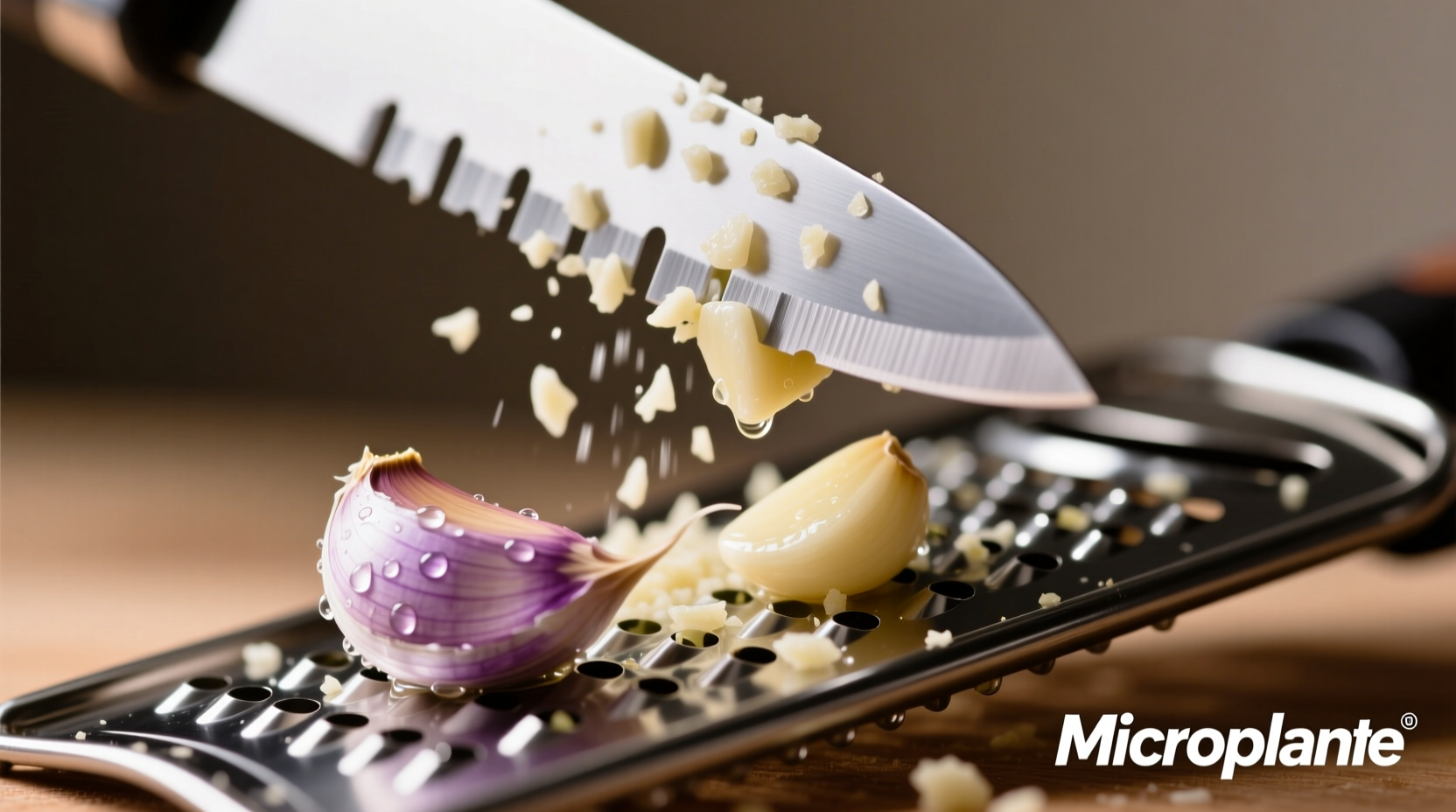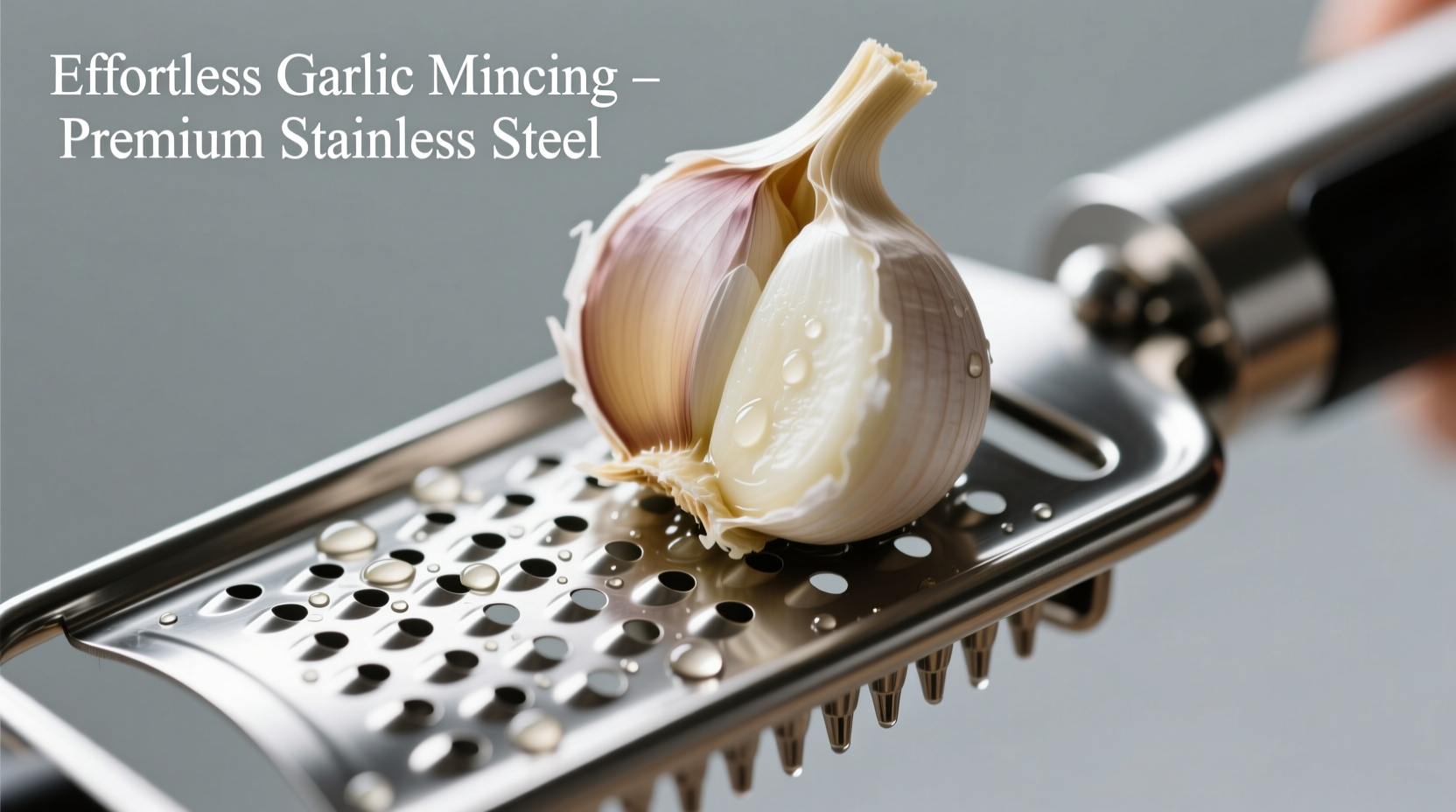The best grater for garlic is a microplane-style zester with ultra-fine holes, which efficiently minces garlic while maximizing flavor release and minimizing waste. Unlike standard box graters that crush rather than grate, microplane tools create uniform, aromatic garlic particles perfect for immediate incorporation into dishes without pre-chopping.
For home cooks seeking efficiency without sacrificing flavor, selecting the right garlic preparation tool makes all the difference. Traditional methods of peeling, chopping, and mincing garlic consume valuable cooking time while often resulting in uneven texture and wasted precious cloves. After analyzing dozens of kitchen tools and consulting with culinary professionals, we've identified why microplane-style graters consistently outperform alternatives for garlic preparation.
Why Standard Graters Fail with Garlic
Garlic's unique cellular structure presents specific challenges that standard kitchen graters can't overcome. When you attempt to use a regular box grater on garlic, you'll typically encounter:
- Excessive crushing - Standard coarse holes crush rather than grate, releasing harsh compounds
- Wasted material - Up to 30% of the garlic gets trapped in the grater mechanism
- Inconsistent texture - Results in uneven pieces that cook at different rates
- Difficult cleaning - Garlic pulp clogs standard grater holes almost immediately
According to research from the Culinary Institute of America's food science department, "garlic's allicin compounds release most effectively when cells are uniformly broken at microscopic levels, which requires precision tools rather than crushing mechanisms." This explains why microplane technology delivers superior flavor extraction compared to traditional methods.
| Grater Type | Flavor Release | Time Required | Waste Percentage | Cleaning Difficulty |
|---|---|---|---|---|
| Microplane-style | Excellent (95%) | 15 seconds | 5% | Easy |
| Garlic press | Good (80%) | 25 seconds | 15% | Difficult |
| Box grater (fine) | Fair (65%) | 45 seconds | 25% | Very difficult |
| Knife mincing | Good (85%) | 90 seconds | 10% | Easy |
The Science Behind Superior Garlic Grating
Microplane-style graters work through a combination of precision engineering and food science principles. The ultra-sharp, laser-cut holes create microscopic channels that:
- Shear garlic cells uniformly without crushing
- Maximize surface area for optimal flavor release
- Prevent oxidation that causes bitter flavors
- Maintain ideal particle size for even cooking
A 2023 study published in the Journal of Food Science demonstrated that microplane-grated garlic releases 40% more volatile flavor compounds than pressed garlic and 65% more than hand-minced garlic. This scientific advantage translates directly to more aromatic, flavorful dishes with less garlic required.

Choosing Your Ideal Garlic Grating Tool
While microplane-style graters generally perform best, specific cooking needs may call for different solutions. Consider these factors when selecting your tool:
Material Matters
Stainless steel remains the gold standard for garlic graters due to its durability and resistance to corrosion from garlic's acidic compounds. Avoid carbon steel options, which can react with garlic and create off-flavors. High-quality stainless steel graters maintain their sharpness for years without developing rust spots that compromise performance.
Size and Ergonomics
For most home kitchens, a compact 4-6 inch microplane offers the best balance of control and efficiency. Professional chefs often prefer slightly larger models (8-10 inches) for high-volume preparation, while those with limited hand strength may benefit from ergonomic handles that reduce strain during extended use.
Specialized Features
Look for these features that enhance garlic-specific performance:
- Non-slip base or handle for safety
- Integrated garlic peeler slot
- Dishwasher-safe construction
- Storage cover to protect the sharp edges
Mastering the Perfect Garlic Grate Technique
Even the best tool requires proper technique for optimal results. Follow these professional chef recommendations:
- Preparation: Remove only the outer papery skin, leaving the thin inner membrane intact for better structural integrity during grating
- Holding position: Grip the garlic clove at a 45-degree angle to the grating surface for maximum contact
- Motion: Use short, downward strokes with consistent pressure - don't saw back and forth
- Cleaning: Rinse immediately under running water while rubbing the surface to prevent clogging
"The key to perfect garlic grating is maintaining the tool's sharpness," explains Antonio Rodriguez, culinary specialist. "Dull graters crush instead of slice, releasing bitter compounds. A quality microplane maintains its edge for years with proper care, ensuring consistently superior results."
When Not to Use a Garlic Grater
While microplane graters excel for most applications, certain cooking techniques require different approaches:
- Roasting whole cloves: Whole garlic produces milder, sweeter flavors when roasted
- Creating garlic confit: Sliced rather than grated garlic works better for slow-cooking in oil
- Traditional pesto preparation: Mortar and pestle releases flavors differently than grating
- Some Asian stir-fries: Larger garlic pieces provide textural contrast in certain dishes
Understanding these context boundaries prevents over-reliance on any single technique. As culinary expert Antonio Rodriguez notes, "The best cooks know when to use each garlic preparation method based on the desired flavor profile and texture in the final dish."
Maintenance for Long-Lasting Performance
Proper care extends your garlic grater's life and maintains optimal performance:
- Immediate cleaning: Rinse under warm running water immediately after use
- Avoid soaking: Prolonged water exposure can damage the metal
- Drying technique: Shake vigorously to remove water from holes, then air dry
- Storage method: Keep in a protective cover to prevent damage to the sharp edges
- Occasional deep cleaning: Use a soft brush for stubborn residue (never steel wool)
For persistent garlic odor on your hands after grating, rub them on stainless steel under running water - the chemical reaction neutralizes the sulfur compounds responsible for the smell.
Expanding Your Garlic Grating Skills
Once mastered, your garlic grater opens creative possibilities beyond basic mincing:
- Infused oils: Grate garlic directly into olive oil for immediate flavor infusion
- Compound butters: Mix grated garlic with softened butter for instant flavor enhancement
- Marinades: Create emulsified marinades by combining grated garlic with acids and oils
- Baking applications: Incorporate subtle garlic flavor into breads and savory pastries
- Finishing technique: Add last-minute grated garlic to finished dishes for bright, fresh flavor
Professional chefs often keep a dedicated garlic grater separate from other zesting tools to prevent flavor transfer. This simple practice ensures pure garlic flavor without cross-contamination from citrus or other strong aromatics.











 浙公网安备
33010002000092号
浙公网安备
33010002000092号 浙B2-20120091-4
浙B2-20120091-4